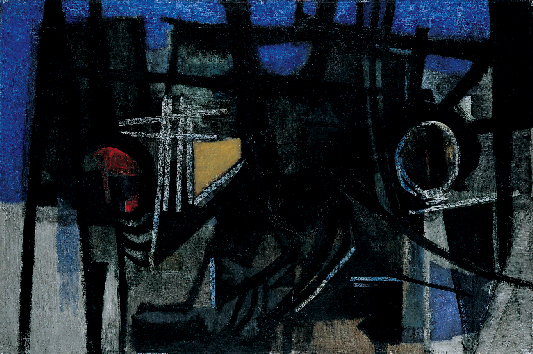“ The resistance constant ” is an exhibition project that aims to provide an overall picture of more innovative research That, from the first years of regional autonomy to the present day , characterized the Sardinian artistic scene . A three-year program which, by 2017, will lead to reconstruction six decades of experimental activity , put in evidence themes, events, groups and personalities .
The identification of a possible “specific connotation” to be recognized within the different experiences, constitutes the backbone of this project. The “ Resistance constant Sardinian ” is a concept with which the archaeologist Giovanni Lilliu tried to express the historical struggle waged by the Sardinian people against the colonial powers which from time to time have appeared on the coasts of the island. “Sardinia,” wrote Lilliu, “at all times has had a strange historical mark: that of having always been dominated (in some ways still today), but of having always resisted. An island on which the oppressive hand of the colonizer has fallen for centuries, to which he has systematically opposed the scratch of resistance. Therefore, the Sardinians had the aggression of integrations of all kinds but, despite this, they managed to always preserve yourself .”
As part of the investigation into artistic and cultural production, the concept of “resistance constant” emerges as an ideal metaphor and at the same time as a privileged viewing criterion through which to observe the development of artistic practices and expressive languages in the light of external influences, of critical debate and national and international trends, from time to time transposed or denied, affirmed or reinterpreted.
The first of three exhibitions, “Twenty-five years of artistic research in Sardinia”, scheduled at the MAN Museum from 17 April to 28 June 2015 , intends to look at the generation of emerging artists between 1957 and 1983 . The time frame identified, as well as the proposed title, refer to an important historical precedent: the exhibition, created in 1983 by the Municipality of Nuoro and by the Consortium for public reading Sebastiano Satta, edited by Salvatore Naitza and Sandra Piras, which aimed to take stock of the production of the last quarter of a century through the work of a large number group of authors of different backgrounds and tendencies.
The choice of 1957 as the start date of renewal process is explained by reason of an event that took place in Nuoro . That year, as part of the Art Biennale, a jury composed of Elena Baggio, Felice Casorati, Mario Delitala, Rodolfo Pallucchini and Marco Valsecchi, awarded the Sardinia Award of painting to Mauro Manca for the work entitled The shadow of the sea on the hill; a cubist painting, which foreshadowed the sign-material experiments that the artist would carry out in the following years, marked a clear watershed between figurative and abstract experiences.
The spread of new languages will be recorded on the island following the Mauro Manca’s transfer to Sassari as director of the State Institute of Art (1959), which under his direction became a reference point for advanced investigations, and with arise in Cagliari of research formations such as “ Studio 58 ” and, in the following decade, the “ Initiative Group ”, active between 1960 and 1965, the “ Transactional Group ” (1966), under the methodological guidance of Corrado Maltese, and the “ Center for Democratic Culture ”, founded in 1967.
The “ Group A ” (1962), which collects the requests of the protagonists of the new Sassari generation. Legacy subsequently implemented by “ Rose Group ” (1976) in which the investigations of those artists who left the Art Institute and returned there as teachers will see the light.
Groups that are not always homogeneous, formed in the two largest cities of the region, to which, in a general framework which also takes into account the geographical and cultural specificities of Nuoro – a production and promotional center of Sardinian culture open to receiving external influences – are placed side by side independent personalities of different orientation.
The Sixties and Seventies in Sardinia they were also the years of committed criticism which, from the pages of local newspapers, saw active intellectuals of different backgrounds (art historians, anthropologists, linguists) in a debate built on the parallel rejection of a closed regionalism and a mannered cosmopolitanism. A complex and sometimes contradictory experience, poised between an internal dimension, of defining one’s own cultural specificity, and an external one, in the awareness of the need to include the Sardinian cultural problems within the framework of international coordinates .
The resistance constant #1. Artists on display: Italo Antico, Antonio Atza, Gaetano Brundu, Paolo Bullitta, Zaza Calzia, Giovanni Campus, Giovanni Canu, Sergio Cara, Giovanni Carta, Tonino Casula, Aldo Contini, Salvatore Coradduzza, Paola Dessy, Nino Dore, Angelino Fiori, Gino Frogheri, Maria Lai, Ermanno Leinardi, Angelo Liberati, Carlo Loi, Mauro Manca, Nicolò Masia, Luigi Mazzarelli, Mirella Mibelli, Rosetta Murru, Luciano Muscu, Costantino Nivola, Primo Pantoli, Igino Panzino, Giuseppe Pettinau, Gaetano Pinna, Giovanni Pintori, Roberto Puzzu, Rosanna Rossi, Vincenzo Satta, Pinuccio Sciola, Giovanna Secchi, Antonio Secci, Agostino Sini, Ugo Ugo, Italo Utzeri.
“The resistance constant” is a multi-year project of the MAN Museum, conceived by Lorenzo Giusti, which will rely on the collaboration of various scholars during its development. The first of three scheduled events, Twenty-five years of artistic research in Sardinia (1957-1983) , is edited by Emanuela Manca, with the consultancy of Rosanna Rossi and Silvano Tagliagambe.

